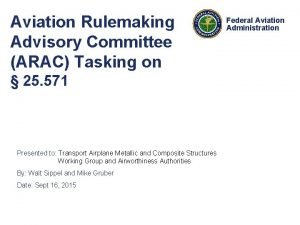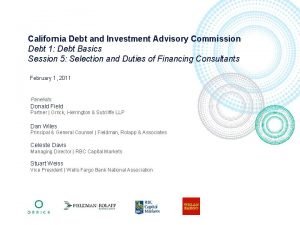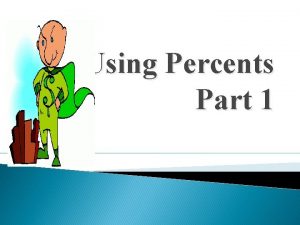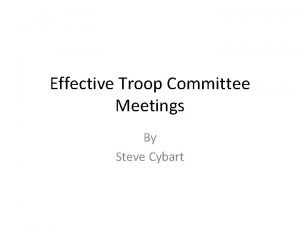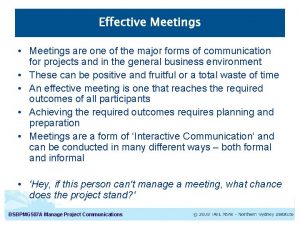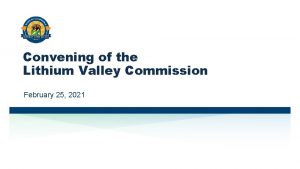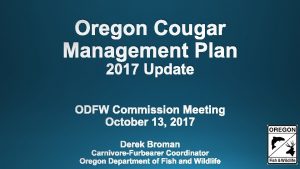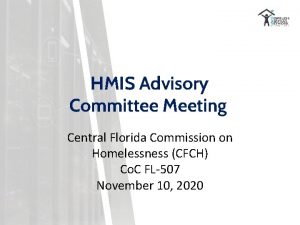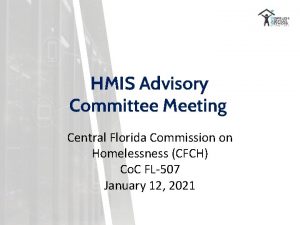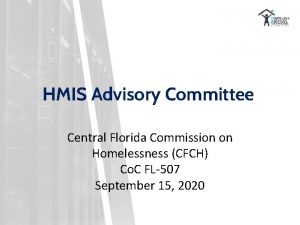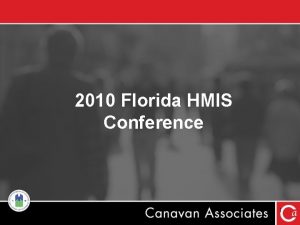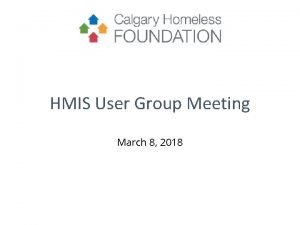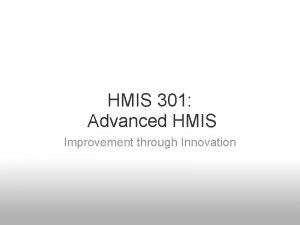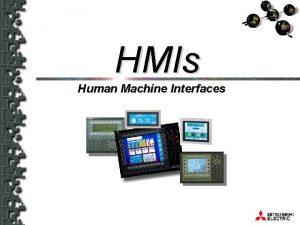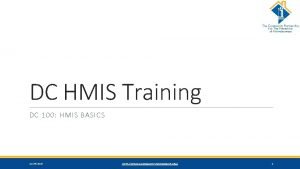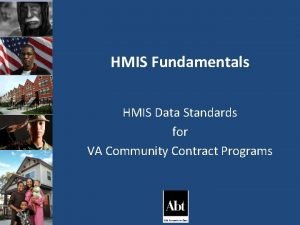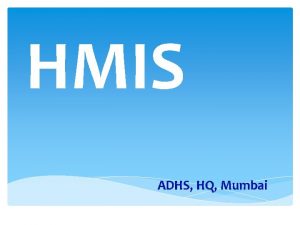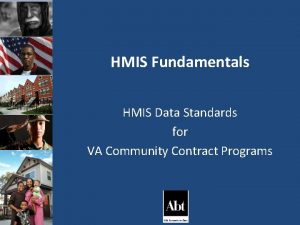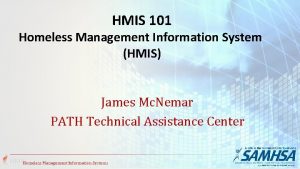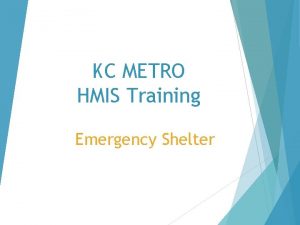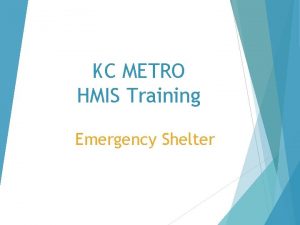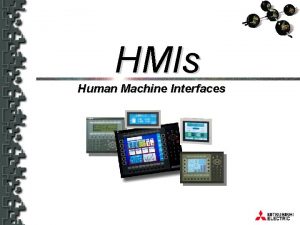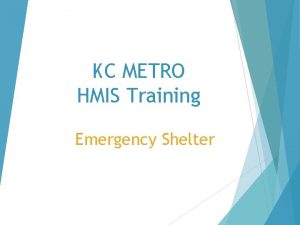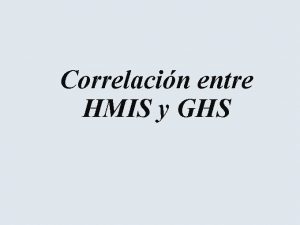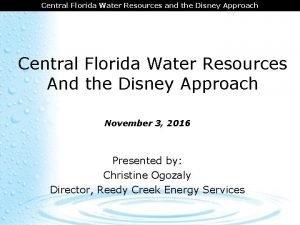HMIS Advisory Committee Meeting Central Florida Commission on






















- Slides: 22

HMIS Advisory Committee Meeting Central Florida Commission on Homelessness (CFCH) Co. C FL-507 March 9, 2021

Moment of Silence Janine Summers We thank you for your life of service to the community.

Agenda ● HMIS Policy & Procedures ● Official HUD Reports ○ LSA Reporting & Stella ■ What does HUD do with the Data? ○ ESG-CV CAPER Updates ○ System Performance Measures (SPMs) ■ What fields are affected? ● HMIS Training & Support ● ○ Street Outreach ○ HMIS Newsletter ○ Data Quality Monitor Scorecards Questions and New Topics/Issues Where does our data go?

HMIS Policy & Procedures ● HMIS Guides, Documents, Training & More ○ hmiscfl. org ● HMIS Guidance for COVID-19 ○ Self-Verification of COVID-19 ○ HMIS Privacy & Security Standards & COVID-19 Response ○ HMIS Project Setup & Inventory Changes During an Infectious Disease Outbreak ● HMIS Manual Coming Soon!

Official HUD Reports ● Longitudinal Systems Analysis (LSA): LSA, Q & A ○ Stella ● System Performance Measures (SPM) ○ Due March 1, 2021 ● ESG-CV CAPER ○ 3 rd Round of Reporting is taking place. ○ Next Qtr reporting period: 1/1/2021 - 3/31/2021 ○ Monthly Required & DQ Reporting is ongoing Resources to Review ESG-CV Requirements: *Only the HMIS Lead is responsible for uploading ESG-CV CAPER Reports.

LSA - Stella ● Longitudinal Systems Analysis (LSA) data was submitted on Jan 15 th, 2021 for fiscal years 18 -19 and 19 -20. ○ ○ ○ This dataset is intended for use in the HUD-supported visualization module known as “Stella”. The dataset is made up of anonymized data about people experiencing homelessness over a 3 -year lookback period, which is then aggregated in Stella Data points include: ■ demographics ■ length of time in programs and length of time to move-in dates ■ exit destinations ■ subpopulations such as veterans and household types ■ returns to homelessness ■ unique to LSA: system pathways, or the way people move through the system to housing On 3/7/21, HUD released the new Stella module for use with the 18 -19 and 19 -20 submissions - views and insights coming soon! You can view the 17 -18 data from Stella here!

SPM ● ● ● System Performance Measures (SPM’s) were submitted on March 1 st, 2021. SPM’s are a series of key performance metrics that help Co. C’s understand system-level data. The 6 key metrics are: ○ Length of Time Spent Homeless ○ Exits to Permanent Housing with Returns to Homelessness ○ Number of Persons Homeless (including PIT Data) ○ Employment & Income-Growth for Co. C-Funded Projects ○ Number of Persons First Time Homeless ○ Exits to Permanent Housing & Housing Retention The 2020 SPM submission will be made available on the HMIS website soon - in the meantime, you can check out past submissions and visualizations here! This year, we elected to resubmit 2019 data due to improvements in data quality and a change in reporting logic from our vendor.

SPM Length of Time Homeless by Entry Date ● ● This measure calculates the amount of time spent homeless in Emergency Shelter and Transitional Housing projects, starting at Project Start Date and ending at Project Exit Date This measure was impacted by a change in reporting logic by our vendor

SPM Length of Time Homeless by Approximate Date Homeless ● ● ● This measure looks at the number of days spent literally homeless according to the Approximate Date Homeless field in the entry assessment, which is a part of the Prior Living Situation section used to determine chronic homelessness This measure includes Permanent Housing projects with move-in dates This measure was impacted by a change in reporting logic by our vendor

SPM Returns to Homelessness ● ● ● This measure examines persons who exited to permanent housing and then returned to literal homelessness in the last 2 years Data is disaggregated by project type and by time-frame of return Overall return rate is 22%, compared to 23% in 2019

SPM Number of Persons Homeless ● ● Official reports includes previous year PIT Data (you can find PIT data from 2020 here!) The Annual Count is a simple count of persons enrolled in Emergency Shelter and Transitional Housing projects during the report period

SPM Employment and Income Growth for Co. C-Funded Projects ● ● This measure looks at adults enrolled in Co. C-Funded projects (PSH, RRH, and 1 TH project) and determines whether they increased income compared to Project Start Date and Annual Assessment, to the Project Exit Date This data is further broken down by whether the income is employment based, or nonemployment based (SSI/SSDI) “Stayers” means people still enrolled and utilizes Income at Start and Income at Annual Assessment “Leavers” means people who have exited and utilizes Income at Start and Income at Exit

SPM Number of Persons First Time Homeless ● ● This measure is a count of persons who are enrolled in Emergency Shelter, Transitional Housing & Permanent Housing projects that were not active in the homeless system in the last 2 years - First Time Homeless This measure is more easily understood as a proportion of first time homeless to non-first time homeless

SPM Exits to Permanent Housing and Housing Retention ● ● This measure counts the number of people with a successful housing income and calculates a percentage of exits that are successful - for Street Outreach this can be movement to shelter or housing, for ES/TH/RRH this is permanent housing PSH is measured as retention of permanent housing - persons who exit to a positive destination are counted, as well as persons who are still enrolled in PSH

SPM Data Quality (Exit Destination Error Rate) ● Data quality of all project types is also submitted with the SPM’s, in the form of the Exit Destination Error Rate. This is the number of exits that were evaluated as “no exit interview completed”, “data not collected”, or any other variation of “unknown”

HMIS Training & Support Upcoming Co. C-Wide Refresher Sessions (March/April) *Invites will be extended to all applicable partners* HMIS 102: Street Outreach HMIS 102: SSVF HMIS 102: PATH ___________________ Routine monthly sessions: 1 st & 3 rd Tuesday: HMIS 101 New User Training 1 st & 3 rd Wednesday: HMIS 101/102 Refreshers 1 st & 3 rd Thursday: HMIS 101/102/103 Reports Training * Additional training sessions may be requested as needed. Join us for our office hours M/W from 1 p - 2 p for additional one-on-one HMIS support. Reminder: All new user training requests must come through the Agency Liaison.

HMIS Newsletter Table of Contents Welcome Highlights/Updates for FY 20 -21 HMIS Privacy & Security Data Quality Corner HMIS Snapshots Comedy Corner Acknowledgements ________________ - A new issue will be released every other month. Each issue will have a data quality theme. Ideas? Submit to us via hmis@hsncfl. org

HMIS DQ Monitors & Scorecards February DQM Stats (Oct 2020 - Current) ○ Data Quality Monitors Conducted = 24 ■ Reviewed approximately 200 projects ■ Primarily focused on the Co. C APR for DQ ○ Corrections for errors in the Co. C APR for entry/exit project due by the next scheduled DQM for your agency (April). ○ If you haven’t already received your report card/feedback, expect it this week. Scorecard for Services Only projects is currently pending. ■ Would like to publicize “grades” on our site after the next round of DQMs Interested in sitting in on a DQM? Let us know at hmis@hsncfl. org!

FL-507 DQ: KEY FOCUS AREAS If there are errors in any of the following sections of your report- we encourage you to prioritize these areas for correcting as they directly impact a number of our federal reports; the logic that is built in rely on one or more of these being accurately responded to. C APR Table 6 b Relationship to Head of Household - helps us associate for HUD the types of households experiencing homelessness in our federal reports Client Location - the FL-507 selection in each entry ensures that enrollment is associated with our Co. C in federal reporting Disabling Condition - a key data point that when paired with the housing questions in Table 6 d allows the system to flag someone that is chronically homeless. Remember there are three parts to this workflow in HMIS. Yes/No. . . the sub-assessment. . . and the additional question within the subassessment on severity per disability selected. Co. C APR Table 6 c Income and Sources at Start - most of our funders require this information Income and Sources at Annual Assessment - required for anyone enrolled 360+ days in a program and designed to be completed around the anniversary of their enrollment date. (30 -/+ days) Co. C APR Table 6 d Chronic Homelessness - these fields, paired with disability, identify who is chronically homeless in our system

Where Does our Data Go? COC: ● ● To help make decisions for provisioning housing and services to homeless individuals & families, including persons at risk of homelessness. Aggregated data is used on NOFA applications for Co. C Funding HUD: ● Reports ○ PIT/HIC - Point in Time/Housing Inventory Count ■ Used to understand sheltered and unsheltered homelessness and bed utilization on a single day ○ LSA - Longitudinal System Analysis ■ Replaced the AHAR, this report/dataset is used to understand the homeless response system over a 3 year period ○ SPMs - System Performance Measures ■ Used to understand 6 different metrics of performance that are considered key to ending homelessness each fiscal year JURISDICTIONS: ● Reports, mandated by Funding Sources on a local level. Community Publications: ● News, Newspapers, Publications, Guides & More.

Questions or New Topics and Issues What’s Next for HMIS? Next meeting date: Tuesday, May 11, 2021 10: 30 am to 12: 00 pm

HSN HMIS Team Angel Jones HMIS Operations Manager Chuck Vroman HMIS System Success Specialist Agustin “Tino” Paz HMIS Senior Data Analyst Racquel Mc. Glashen HMIS Partner Success Specialist Brittney Behr HMIS Data Analyst Tyler Claitt HMIS Partner Support Specialist
 Working with models
Working with models Learning without burden was the report of
Learning without burden was the report of Trade union advisory committee
Trade union advisory committee Federal advisory committee on insurance
Federal advisory committee on insurance Aviation rulemaking advisory committee
Aviation rulemaking advisory committee California debt and investment advisory commission
California debt and investment advisory commission California debt and investment advisory commission
California debt and investment advisory commission Difference between committee and commission
Difference between committee and commission Utilities commission nsb
Utilities commission nsb Objectives of mudaliar commission
Objectives of mudaliar commission What is graduated commission
What is graduated commission Troop committee meeting agenda
Troop committee meeting agenda Steering committee meeting agenda sample
Steering committee meeting agenda sample Safety committee meeting ppt
Safety committee meeting ppt Tcm technical committee meeting
Tcm technical committee meeting Lithium valley commission meeting
Lithium valley commission meeting Odfw commission meeting
Odfw commission meeting For todays meeting
For todays meeting Today meeting or today's meeting
Today meeting or today's meeting What is meeting and types of meeting
What is meeting and types of meeting Types of meeting
Types of meeting Apk 2300 ucf
Apk 2300 ucf Jain society of central florida
Jain society of central florida




